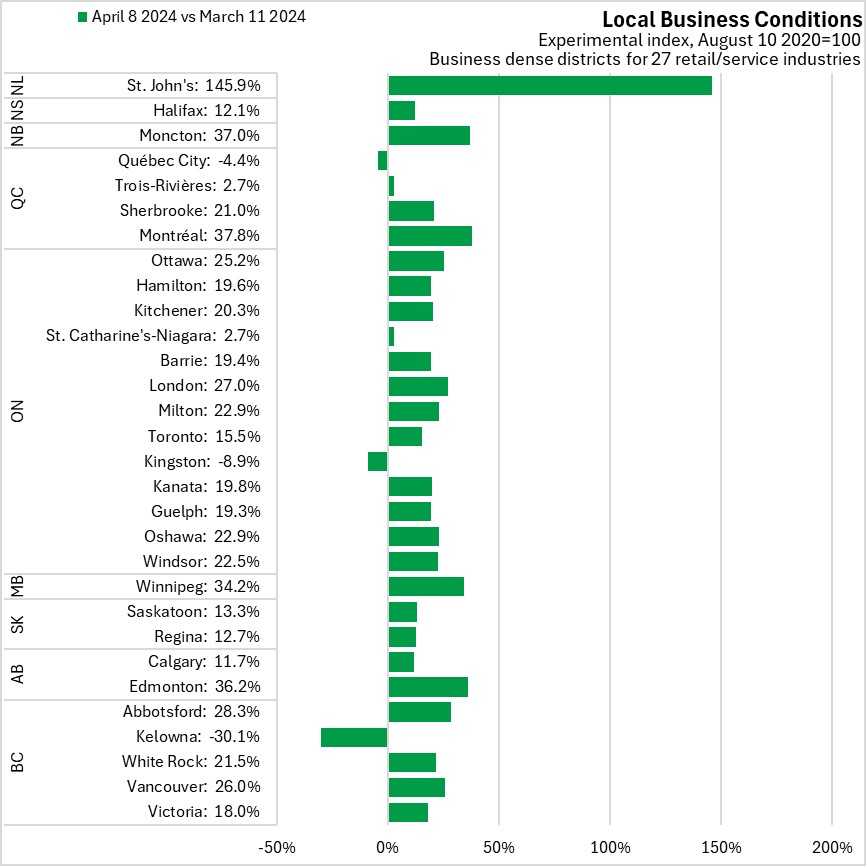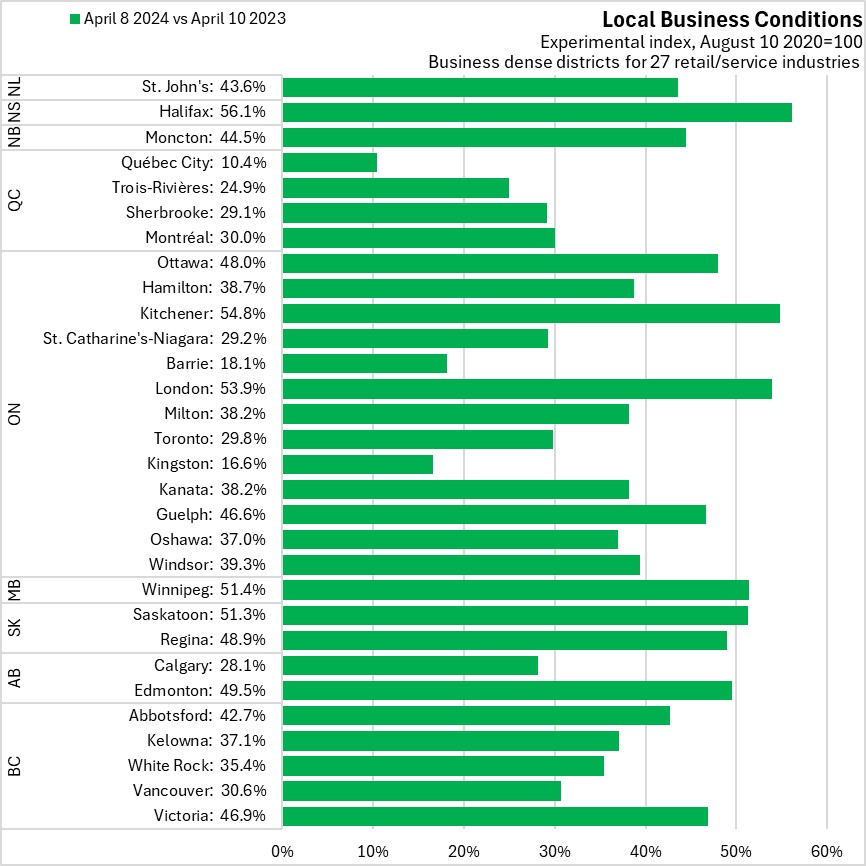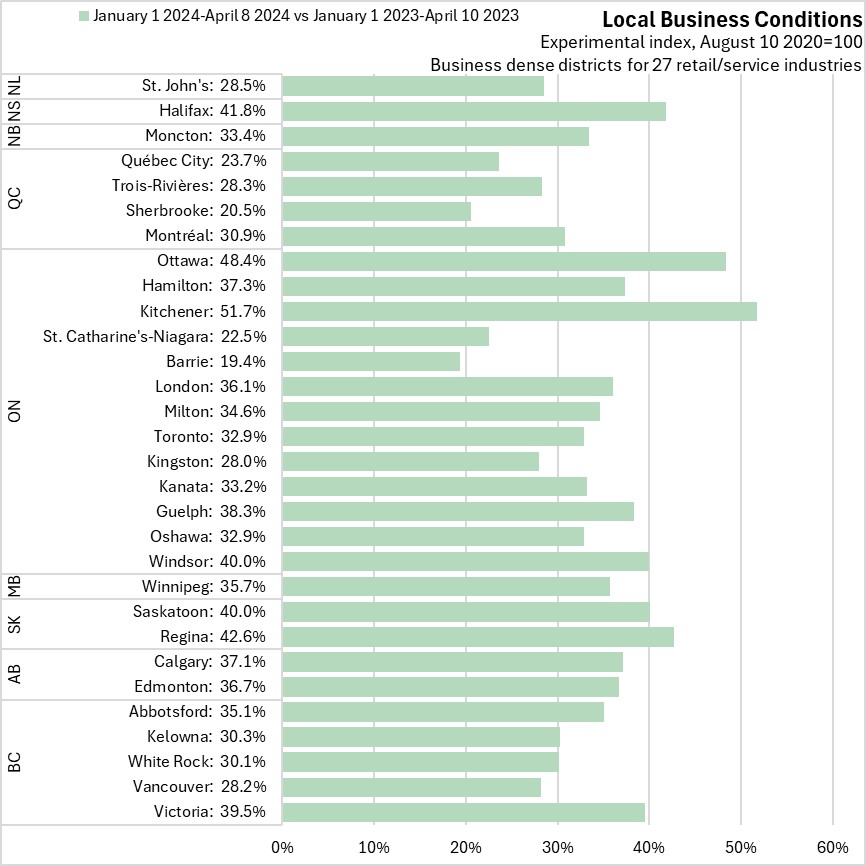April 12, 2024HALIFAX BUSINESS CONDITIONS: APRIL 1-7, 2024 Statistics Canada has released real-time local business conditions from April 1 to 7, 2024. Reference dates reported now refer to the date following the end of the reference week.
Note that these data are not adjusted for seasonality and monthly or weekly changes may simply reflect regular seasonal patterns.
From August 10 of 2020 to April 8, 2024, the local business conditions index for Halifax has increased by 196.0%. In percentage terms, St. John's reported the strongest growth in business conditions over this period while Halifax had the smallest gain (just behind Hamilton).

Halifax business conditions improved by 4.2% in the week ending April 8. Of 30 urban centers, 18 reported improving business conditions compared to the week prior, with the largest decline in Québec City. St. John's reported the largest improvement.

Compared with four weeks prior, business conditions were up 12.1% in Halifax. 27 of 30 urban centers reported growth over the four weeks with St. John's leading in growth. Only Québec City, Kingston and Kelowna reported declines in business conditions.

Comparing previous week with the same week a year ago, Halifax business conditions have improved by 56.1% - the largest year-over-year gain among cities (just ahed of Kitchener). All cities reported improvements over the same period last year. The smallest improvement was in Québec City.

As the experimental business conditions index is both volatile and unadjusted for seasonality, a comparison of year-to-date averages may generate more stable (if less current) insights into changing business conditions.
Compared with the first fourteen weeks of 2023, Halifax business conditions were up 41.8% in the same period of 2024. Over this period, Kitchener and Ottawa reported the largest gains while Barrie and Sherbrooke reported the smallest gains. No urban centres reported a year-to-date decline in business conditions.

Halifax's business conditions generally follow trends observed in Canada's largest urban centres (those with populations greater than 800,000). Halifax business conditions do deviate from others during spikes from weather or cultural events.
Halifax's business conditions typically deteriorate more than others in the first months of the year and post a strong recovery in the spring, followed by stable conditions over the summer. This pattern appeared to be repeating this winter with a sharp decline at the start of January. Conditions appear to be rebounding faster than in the three previous years in Halifax. Despite recent improvements, Halifax's business conditions lag those of all large urban centres.

Several medium-sized cities (population >250,000) reported sharp growth in business conditions over the holiday season, followed by a sharp contraction early in the new year. Despite the recent rebound, Halifax continued to report the weakest business conditions among medium-sized cities.

Halifax business conditions also remain behind all those of smaller urban centres (population <250,000).

Notes
This experimental data product starts from information on the number of businesses listed in the business register in "business dense areas" of a large urban centre. Data from 2019 business locations provided baseline (ie: pre-pandemic) insight on business revenue and employment.
The data focus on 27 industries in particular: retail bakeries, furniture stores, electronics/appliance stores, building materials/garden supply stores, food/beverage stores, gas stations/convenience stores, clothing stores, cycling stores, book stores, general merchandise stores, florists, cinemas, dental offices, museums, zoos/gardens, amusement/theme parks, casinos, fitness/recreation centres, bowling alleys, drinking places, restaurants, and personal care services (such as hair care or esthetics).
Data on current operating conditions (open vs. closed) were collected from commercial application-program interfaces (API). Most of the information is drawn from Google's Places API, which is similar to what is available publicly on Google Maps, with supplementary information from APIs offered by Yelp Fusion and Zomato. Queries to the API are based on a sampling approach ('density-based cursory search') that focuses on the densest areas for business locations in the selected industries. Statistics Canada cautions that the sampling methods used do not follow standard statistical methods due to cost and technical limitations.
Data on current traffic volumes were drawn from TomTom's historical traffic information. As with operating conditions, the information was drawn from a sample of routes within identified business-dense areas. Statistics Canada cautions that traffic volume estimates and their relationship to business conditions may be sensitive to changing traffic patterns, construction/detours, and changes to business models such as curbside pickup or delivery.
The index of real-time local business conditions is estimated as the value of retail revenue, adjusted for both percentage of reported business closures as well as changes in traffic volumes from pre-pandemic levels.
The value of the index was set to 100 as of August 2020. As such, the index shows changes since then, but does not represent the variations in business conditions that existed in the initial period. A location with strong local business conditions in August 2020 would have less opportunity to grow than a location with weak conditions in the same month.
Source: Statistics Canada. Table 33-10-0398-01 Real-time Local Business Condition Index (RTLBCI)
Statistics Canada catalogue 71-607X. Real-Time Local Business Conditions Index: Concepts, data, methodology, https://publications.gc.ca/collections/collection_2021/statcan/71-607-x/71-607-x2021017-eng.pdf, July 15, 2021